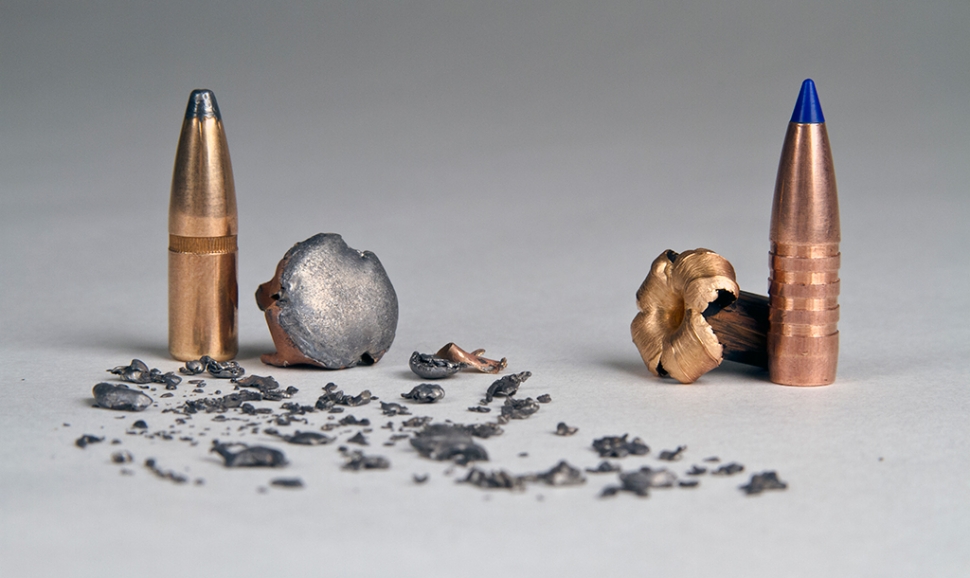|
Feeding the Birds and Making Sense of Non- Lead Ammunition
 A shot lead bullet (left) and its fragments compared to a modern copper monolithic bullet (right). Many are switching to non-lead for its performance and safety for scavenging wildlife. Courtesy Hunting and Conservation Outreach, Great Basin Institute, Ventura Office. By Anonymous — Thursday, June 17th, 2021
Summer is finally here, a time when California deer hunters are dreaming about filling their empty freezers and when ranchers are seeing a proliferation of new ground squirrel burrows plaguing their fields. Most hunters and ranchers alike use a firearm to either provide their families with wholesome game meat, or reduce the population of destructive species. In 2020 both these groups saw Assembly Bill 711 (2013) in effect for its first full year, banning the use of lead ammunition for hunting of wildlife. The legislation was aimed at addressing lead poisoning deaths in scavenging wildlife, most notably the California condor. Multiple studies have traced a link between the use of lead ammunition and mortality in raptor populations, including bald and golden eagles. Lead has deep historical usage in hunting projectiles since it is dense, malleable, and easily mined but it tends to remain in the environment for many years. Shot lead bullets can fragment hundreds of times into an animal, especially when placed on hard tissue. The microscopic pieces left behind in unrecovered game, gut piles, or dispatched livestock become available to scavengers who unfortunately can succumb to lead poisoning. The new restrictions aside, hunters and ranchers continue to contribute to conservation. Revenue from license and gun/ammo sales are crucial sources of funding for wildlife conservation, while the modern diets of scavengers like the condor rely almost entirely on cattle and large terrestrial game. Making the switch to non-lead provides a clean source of food for condors and other scavenging raptors that frequent the area around Fillmore, and hunters and ranchers who shoot with non-lead are some of the most important stakeholders in the recovery of California’s raptor populations. Center and Rimfire As a previous Gazette contributor pointed out, you first need to understand how alternative metals fly, then test how new rounds perform with your particular firearm. The difference between densities of lead and copper (the most common non-lead option) alters the flight path and may require resighting. Copper bullets may come with a polymer tip to improve accuracy and expansion of their copper petals such as the Barnes TTSX, Hornady GMX, Federal Trophy Copper, or Nosler E-Tip, while others have an exposed hollow point such as Sig Sauer’s Copper Elite, Barnes TSX, and the Federal Copper HP. The monolithic design undeniably has better weight retention and penetration which is crucial for quickly dispatching tough species like feral hogs or large livestock. They are all manufactured with strict specifications to consistently expand and release their energy on target. For ranchers and hunters conducting nuisance species management or harvesting furbearers, an appropriately sized round may be available as a frangible. Frangibles are copper-jacketed and filled mainly with powdered copper alloy core to create a single entrance and release their energy rapidly. Options such as the Barnes Varmint Grenade, Hornady NTX, and Nosler Ballistic Tip Lead Free are excellent choices. The offerings for the old iron sight rimfire rifle now include Hornady NTX, CCI Copper-22, and Norma ECO. Although these lead alternative options are less dense and destabilize in flight at longer ranges, this is not much concern for standard rimfire hunting conditions. Shotgun The lead-free options available for the various gauges and applications of shotguns are too numerous to mention here but the alternative metals- steel, bismuth, tungsten, or alloys of them should be tested to identify if they are conducive to your firearm. At the end of the day the firearm chooses the best performing ammunition, not the shooter. Check that your gun is rated for these harder alternatives as older models and Damascus steel barrels can get damaged. Shot sizes will also change. Steel, as a rule of thumb, should be shot one to two sizes larger than a shooter’s previous lead load, while tungsten can be shot 3 or 4 sizes smaller. A modification of choke size may be in order regardless. Note- if you find small upland loads like size 6 steel right now, congratulations on winning the California lottery. If competing for rifle and shotgun ammo is running you ragged, many hunters are now switching to air rifles. Unlike the farm’s old Red Ryder, modern designs of pellet rifles can fire a projectile in excess of 1500 feet per second. Pellet alternatives include copper and alloys of tin, bismuth, and zinc that are capable of performing better than lead counterparts. Researching larger calibers like .22 or .25 can help you find a gun and pellet combination that matches your needs, and the best part is that they both ship without a background check right to your door! Some popular options there are Haendler & Natermann H&N Baracuda Green, Predator GTO Lead-free, and Daisy Precision Max Flat Lead-free. Practicing at varying distances can increase confidence in your bullet choice and lead to success in any scenario. By researching rounds you see on the shelf, thoroughly cleaning guns to remove metal residue, testing multiple options, or buying a rifle with a higher twist rate you can ensure your aim stays true and your target goes down humanely. Ammunition shortages are still very real so it is in the best interest to start buying your ammunition several months ahead of season and get cozy with your local purveyor. Hunters and ranchers- take pride in the knowledge that you are contributing to the propagation and recovery of scavenging species by shooting non-lead ammunition. You are making the recovery of species such as the California condor possible, all while continuing the sportsman’s tradition of conservation. If you would like to learn more about the why and how of switching, visit www.huntingwithnonlead.org. |
